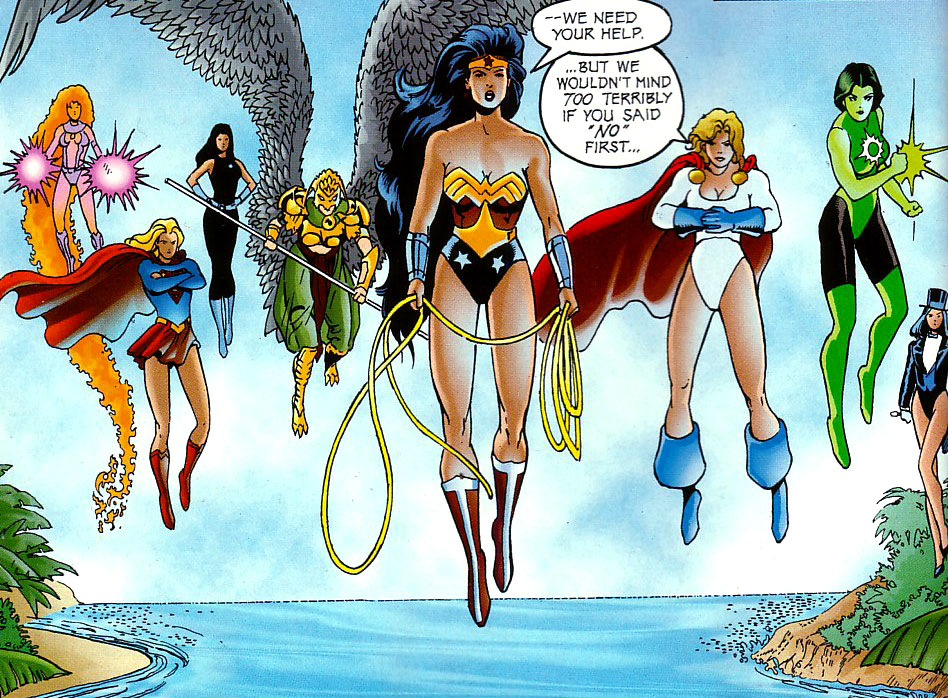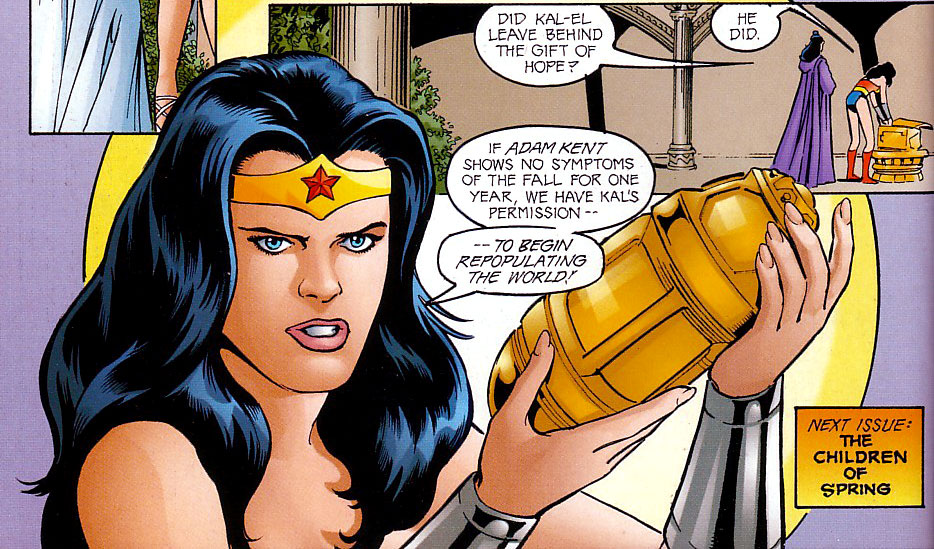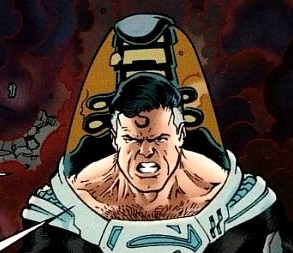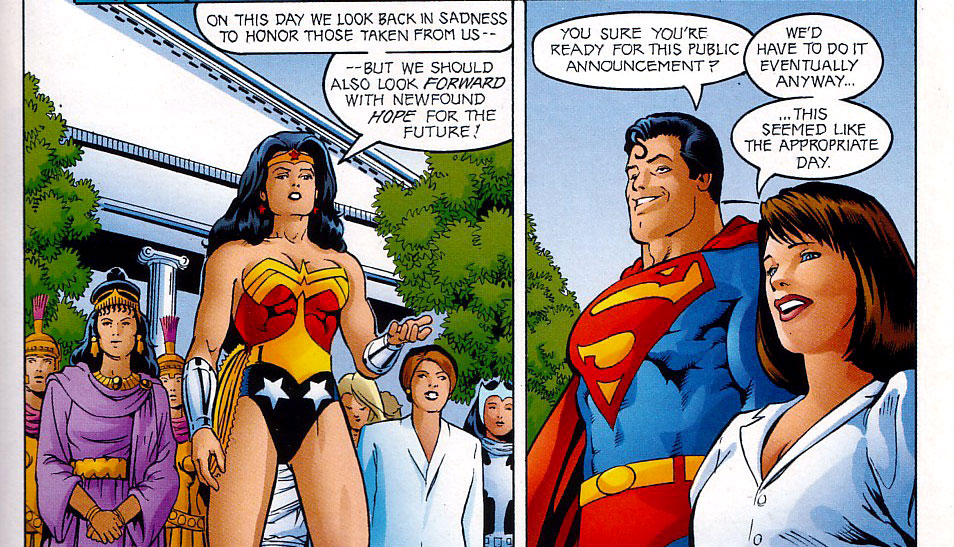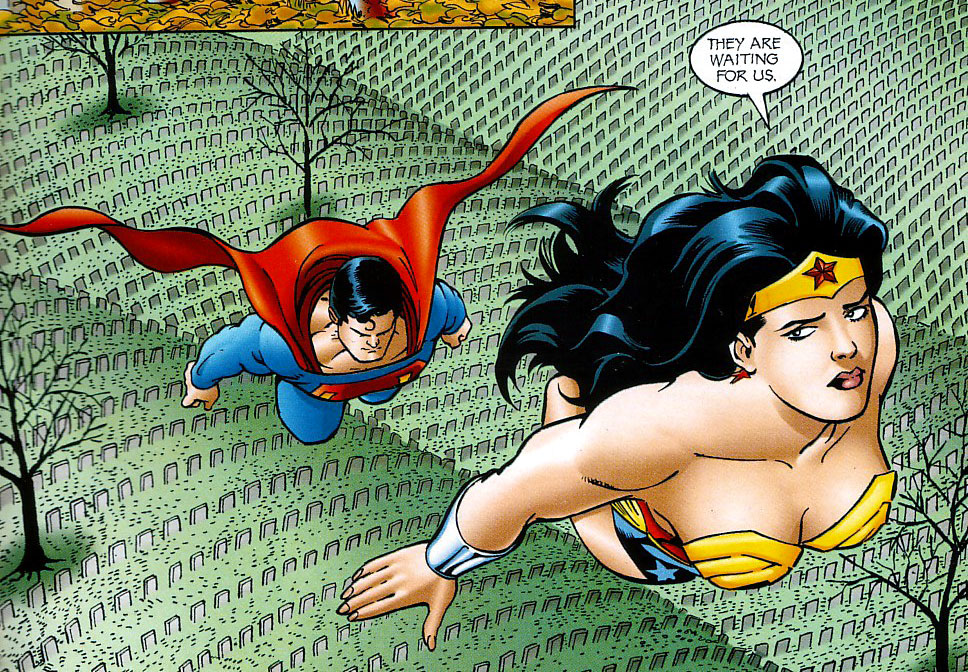For my birthday a few weeks back, I had a couple of beers and then went longbox diving for random things I vaguely remember that are not available digitally, not least because I could then write posts about them here. This is one of those things.
THE BOOK: JLA: Created Equal #1-2, a two-issue prestige-format Elseworlds limited series published by DC Comics in 2000.
THE CREATORS: Written by Fabian Nicieza; penciled by Kevin Maguire and inked by Joe Rubenstein; colors by Gloria Vasquez (#1) and Pat Garrahy (#2); and lettered throughout by the great Bob Lappan. Man, do I love Lappan’s lettering over Maguire’s art.
THE CONCEPT: Just as the 21st century started up, DC Comics would publish a self-contained series featuring an exploration of Earth after all the men were killed in a mysterious incident. It is full of fun speculative fiction and a few thoughtful explorations of the concept of a world without men. That series was Y: The Last Man. Two years before that, though, they would publish this limited series, setting the same rough plot in the DC Universe. It is full of, um, pages, mostly. And also depressing prescience.
(Yes, I am aware that neither this series nor Y: The Last Man invented the last-man-alive-in-a-world-of-women concept. It still struck me as odd—and still does!—that DC/Vertigo went to this well twice within two years, albeit in two very different ways.)
Snark aside, the story here is this: Radiation from a cosmic storm kills all the men on Earth. (This happens literally in the turn from page 3 to page 4 of issue #1. This is not a series that spends a lot of time with throat-clearing.) The only known male survivor is Superman; Lex Luthor has also survived in secret, sealed off from the world and working feverishly to understand the cause of the event, and any possible solutions. Also, get this: WOMEN RUN THINGS!!!! LOL!!!! Can you EVEN imagine?!??
Okay—the tone isn’t QUITE that bad, but it’s…I don’t know. Problematic, maybe?
As with so many Elseworld stories, it’s tough to boil down the plot, because what’s really interesting is not the rising action/climax/denouement structure, but what happens to the world as a whole that the story is set in. Here we have the formation (or formalization, I guess) of an all-woman Justice League; the installation of Paradise Island as the capital of the world; the creation and raising of a whole race of Superman babies; and, running through it all, Lex Luthor attempting to complete his Evil Plan to, um, be an enormous asshole. Then there’s a lot of punching and stuff.
I don’t quite remember how this read back in 2000; I know even at the time I wanted it to be something else—something more like what Y: The Last Man would wind up being, actually—but I know it reads very differently now. In the age of Trump and of RedPillers and of GamerGate, when we see the noxious villainspeak from this series online every single day passing as interpersonal discourse, there’s a weird and hugely depressing prescience about the whole thing. It’s like Nicieza correctly identified the worst traits in male nerd culture—and especially white male nerd culture—but assumed that would OBVIOUSLY be the purview of villains, not of, you know, a whole bunch of everyday people.
Again, I know we had seen this before, a lot of times—there’s a lot of the then-out-of-print-and-semi-legendary Alan Moore Miracleman in here, in a watered-down version processed through Nicieza’s uniquely 1990’s filters—but, I mean…
Look, what happens in the back two-thirds of this story is that, after Superman knocks up Lois, Luthor emerges from hiding to reveal that Superman himself is a danger to any potential male birth. (Blah blah blah his Kryptonian cells stored the cosmic energy blah blah blah whatever.) Superman, as he tends to do in such situations, exiles himself from Earth to search the spaceways for something or another. But he leaves behind what Hippolyta calls “the gift of hope,” which I guess is a big ol’ jar of what we’ll euphemistically call Superman’s “genetic material,” so that they can repopulate the Earth.
(That’s the end of issue #1. Let that sink in for a minute: the cliffhanger of the first part of this series is Wonder Woman holding a huge jar of super-sperm. “The gift of hope.” Good lord, this book.)
ANYWAY, the kids all have powers and the Amazons and try to raise them smartly, but Luthor brainwashes them and uses captive psychics to poison their hormonal teenage brains (we’ve flashed forward a bit) and turn them eeeeeeeeeevil, and they attack their caregivers and, I dunno, a bunch of other stuff happens and in the end Superman returns and the kids are ostensibly redeemed and the story eventually ends.
My point is: the climactic battle in this book is a megalomaniacal 1980’s-style businessman marshalling the seething, stupid rage of angry teenage white boys against a world run by a diverse group of women. It is a LITTLE BIT of a tough read in 2017, is what I’m saying.
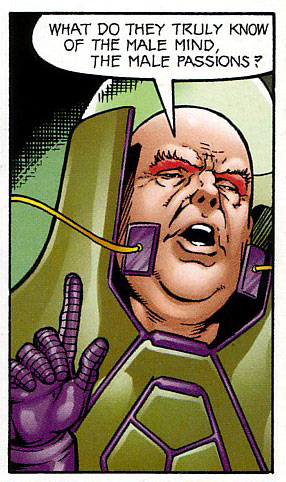 Here, try to guess if the following quotes are lines of dialogue from this series or angry screeds from 4chan and Twitter:
Here, try to guess if the following quotes are lines of dialogue from this series or angry screeds from 4chan and Twitter:
- All of you, the male-born Children of the Spring, were denied a natural upbringing! You have been raised with no real understanding of a man’s rule in creating and defining human civilization!
- You have been raised by women who fear you! They have forced you to be less than you can be! You cannot define yourselves by their standards! You must be given the opportunity to learn about your heritage! You deserve the right to know how society was and how it was meant to be!
- Mankind’s history was founded and built on strength—physical strength as well as strength of character! We were a goal-oriented, success-oriented race! The planet was not intended for us to live in harmony, but rather for us to tame and master.
- You have been cheated by your … upbringing, robbed of your birthright as men! This current world is an aberration—nothing but a hiccup in the way things have always been, and will be once again!
- They fear your power! They fear your strength! They fear you will regain your rightful place of dominance in their precious new world order!
It’s a dumb trick question, of course. They’re all from the book. So…yeah.
(I want to be very clear: this worldview is definitely portrayed as nasty and unpleasant and evil and generally un-good. I am ascribing the above sentiments neither to Nicieza nor to any sympathetic character in the story. It’s just not exactly the fun, light-hearted read I tend to hope for from a Kevin Maguire-drawn book.)
WHAT WORKS:
- I love me some Kevin Maguire art, especially in the days before he went primarily digital, and he’s mostly on point here. He always gets praise for his facial expressions and physical acting, but not enough people mention how well he does straining neck muscles. Check this out:
- It’s a good high-concept, and Nicieza occasionally finds a clever way to use it. Luthor’s arrival on Paradise Island is well-executed, for example. And the pageturn that kills all the men is a genuinely terrific way to start an issue.
- Um, Bob Lappan’s lettering is nice?
WHAT DOESN’T:
- Oh, lord. Where to start.
- My love of the pageturn massacre aside, the pacing in this series is absolutely bizarre. There are pages given over to random scenes that could definitely have been put to better use in improving the overall story flow. One example: the first page introduces Kyle Rayner’s neighbor, a comedienne named Maria Contranetti. (In fact, she’s the first speaking character, and the first non-spacescape panel is a flyer for her comedy show.) Kyle blows her off on his way to a Justice League emergency. Then, some 20-odd pages later, we learn that she found Kyle’s ring and is using it for crime, and then we devote FOUR full pages to the post-event Justice League fighting her to take the ring. Then, one more page for them to present the ring to Barbara Gordon. This five-page detour adds nothing to the story that couldn’t have been achieved by having Oracle get the ring directly from Kyle. (And, to be totally honest, Oracle Green Lantern is itself a mildly fun concept that really amounts to nothing in the long run.) There are more of these—A dramatic full page devoted to Hawkgirl deciding to stay on Earth! WAY too many dream sequences! A full page dedicated to Zatanna getting no helpful information from the magical DC crew that always shows up at events like this!—and they’d all be fine if the spine of the story were strong enough to carry them along.
- It isn’t.
- By the time the entire generation of Superpeople is teenaged, we know very little about them, either as individuals or as a group, and a lot of what we do know comes only as part of Luthor’s psychic intrusions. It’s real tough to care about these kids, especially because…
- Superman and Lois’s kid (aged 5) accidentally kills Lois by hugging her too hard. It’s the kind of moment that’s trying for horror and heartbreak and just feels unearned and tiring. And it sure as hell doesn’t make me want the best for this kid, even before he become a whiny, brainwashed Gamergater.
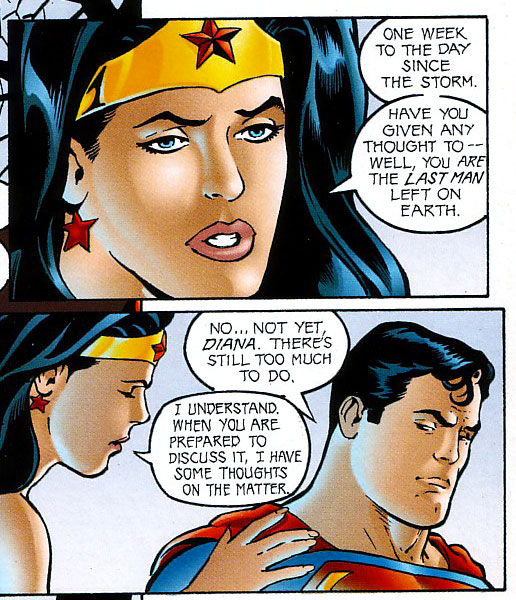 There’s a running subplot in the first issue that basically amounts to “Will Superman manage to impregnate Lois? Should he maybe impregnate, like, a BUNCH of women? Isn’t he gonna bang Wonder Woman at some point?!?!?” and, for me at least, it landed cringe-worthy as hell. On both a creative level and a character level (for Diana, mainly), this fixation feels kinda unseemly. “If a normal human can’t accommodate a Kryptonian birth,” Wonder Woman says, and Superman finishes, “There will be metahuman options… I know.” And, look, Maguire can be a hell of a cheesecake artist, and if you wanted to make this story a zany last-superhero-on-Earth sex-comedy it…well, honestly, it would probably be a better book, and certainly one I’d be much less squicky about. But this…ugh.
There’s a running subplot in the first issue that basically amounts to “Will Superman manage to impregnate Lois? Should he maybe impregnate, like, a BUNCH of women? Isn’t he gonna bang Wonder Woman at some point?!?!?” and, for me at least, it landed cringe-worthy as hell. On both a creative level and a character level (for Diana, mainly), this fixation feels kinda unseemly. “If a normal human can’t accommodate a Kryptonian birth,” Wonder Woman says, and Superman finishes, “There will be metahuman options… I know.” And, look, Maguire can be a hell of a cheesecake artist, and if you wanted to make this story a zany last-superhero-on-Earth sex-comedy it…well, honestly, it would probably be a better book, and certainly one I’d be much less squicky about. But this…ugh.- Seriously, can we talk some more about the “Gift of Hope”? How did they extract enough, um, genetic material to fill that container and supply all the in vitro fertilizations we’re told about in issue #2? Private room and some magazines? Not to go all Mallrats on this, but…it’s just another weird decision. Why not do a wacky science/magic combo or something and just elide this vaguely unpleasant plot point entirely?
- The story spends very little time on the non-superheroic side of the post-male world, which seems like a huge wasted opportunity.
- In fact (and somewhat weirdly, given the overall plot) the story manages to really let down the women of the DC Universe. The post-Fall world is far too chaotic for far too long, with the weird, lingering implication that women just can’t hack this kinda thing. By the time the final conflict rolls around, the entire world of experienced superheroic women is outmatched by the angry teen boys. In-story, this is explained away as being because they’re out of practice; on the meta level, they have to struggle because otherwise there’s no conflict. But the resulting story beats—Wonder Woman, an army of Amazons, and a whole bunch of lady superheroes getting beaten and strung up, until Superman arrives to save them—are really depressing in their unwillingness to give cool hero moments to the women of this notionally woman-centric story.
- Even Maguire’s art goes wonky at points. He usually works well with Rubenstein’s inks, but in all too many pages and panels here there’s a stiffness and odd shape to the faces that looks far more Barry Kitson than Kevin Maguire.
SHOULD IT BE ONLINE: Ugh, I dunno. I guess so? Maybe I’m just too square to enjoy it or something, and if it were online everyone could find out for themselves? I’m definitely not planning on returning to it anytime soon, though.
